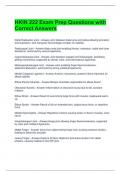Exam (elaborations)
HKIN 222 Exam Prep Questions with Correct Answers
- Course
- Institution
HKIN 222 Exam Prep Questions with Correct Answers Distal Radioulnar Joint - Answer-Joint between distal ulna and radius allowing pronation and supination, with triangular fibrocartilage complex for stability. Radiocarpal Joint - Answer-Major wrist joint enabling flexion, extension, radial and u...
[Show more]



